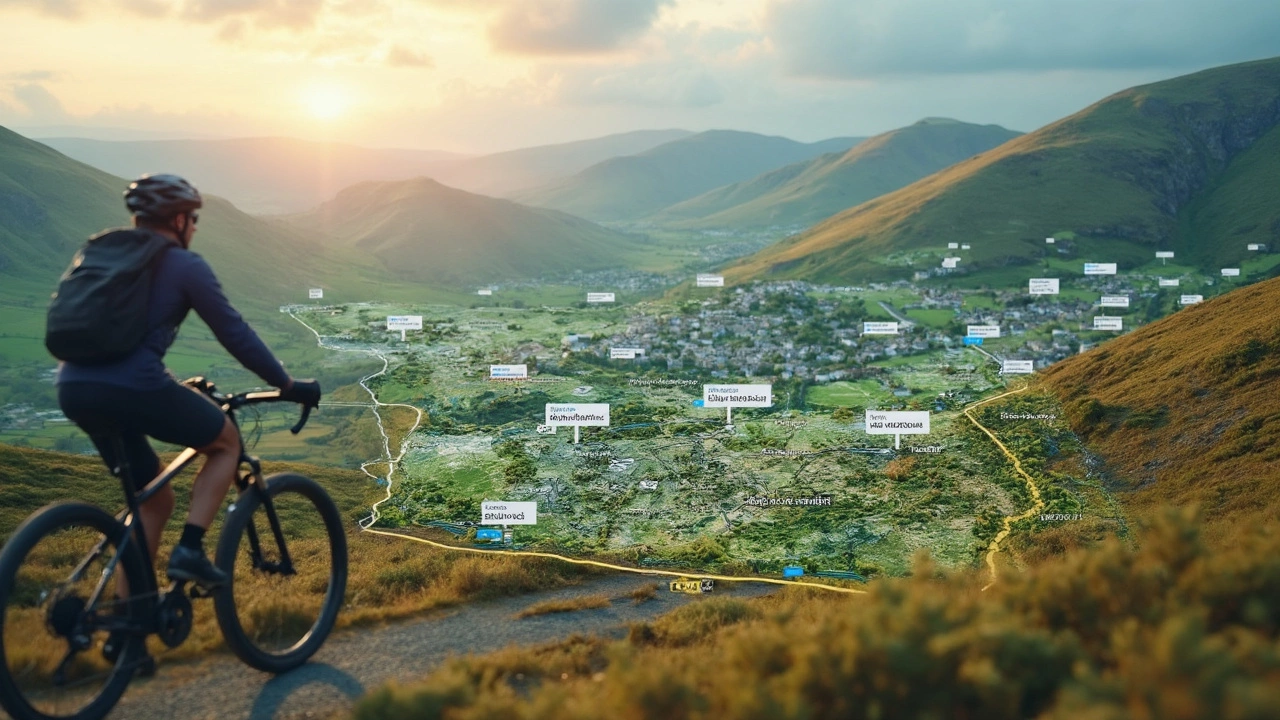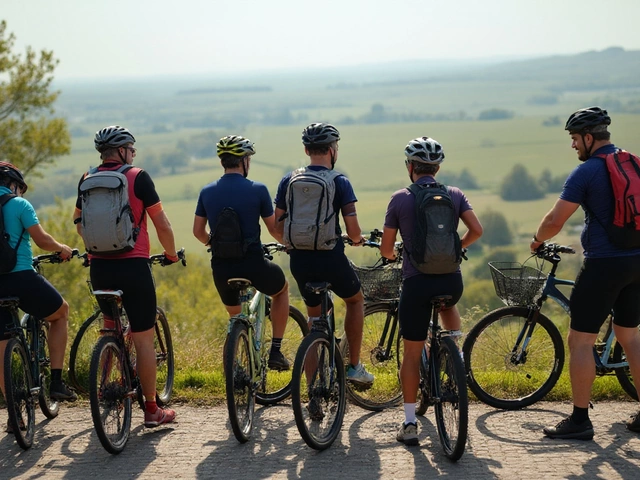Master Bike Routes with Google Maps: Your Ultimate Guide

Think biking is just about pedaling? There's a whole lot more to it, especially when you top it off with some nifty tech. Google Maps isn’t just for driving directions; it's a cyclist's best friend too, if you know your way around it. Imagine breezing through town, effortlessly finding green paths while avoiding those pesky one-way streets that seem to have it in for cyclists.
Started yet? First off, fire up Google Maps and hit that Directions button. Choose the bicyclist icon to get bike-specific info. This view highlights designated bike lanes, paths, and routes, so you're not just winging it. Did you know that Google Maps can even tell you which paths are off-road or if they might be a bit too hilly? It’s like having your very own local riding guide in your pocket.
- Getting Started with Google Maps
- Finding the Best Bike-Friendly Paths
- Customizing Your Bike Routes
- Exploring New Trails
- Advanced Navigation Tips
Getting Started with Google Maps
Let's talk about the basic setup, so you can make the most of Google Maps for your biking adventures. It's not just for drivers. If you're new to the app or haven't explored its full potential for bike routes, here's where you start.
Setting Up Your Route
First things first, open the Google Maps app on your phone or head to the website. Type in your destination and tap on 'Directions.' You'll see some icons at the top for different modes of travel. Choose the bicycle icon because, why else are we here?
Now that you've got your mode sorted, it's time for details. Include a start point if Maps doesn't auto-detect your location. Instantly, you'll get options tailored to cyclists. Google Maps has this nifty way of showing you bike-friendly streets and dedicated cycles lanes in green lines. Don't ignore them; they're your new best friends.
Explore Options
- Look for dotted lines—they often indicate off-road trails, which can be a more peaceful and scenic way to get around.
- If you’re in a rush, look for straight-line roads; they usually mean fewer stops.
- Hover over the route to get an idea of elevation and traffic on that path.
Once you're happy with the route, tap 'Start' for turn-by-turn navigation. Make sure to have your phone charged and maybe a portable charger just in case. Remember, the city can be unpredictable.
Did You Know?
Google Maps is pretty smart. It can even reroute you automatically if there are obstacles on the road like unexpected construction. Maps updates its traffic conditions every few minutes, ensuring that your path is always optimized. So, keep your data on if you can.
| Feature | Benefit |
|---|---|
| Real-Time Traffic Updates | Helps avoid delays |
| Bicycle Mode | Displays safest bike paths |
| Elevation Data | Plan for hills and slopes |
Take these initial steps, and you'll find that using Google Maps for cycling is effective and, dare I say, quite fun. Happy cycling!
Finding the Best Bike-Friendly Paths
When it comes to cycling bliss, bike routes that truly cater to cyclists can make all the difference. Finding these bike-friendly paths on Google Maps is relatively simple but highly rewarding. Let's break it down.
Using the Terrain Layer
One cool feature is the terrain layer. It shows the topography of your route, which is super handy if you’re trying to avoid gnarly hills. Just activate it by hitting the 'Layers' button and selecting 'Terrain'. You'll get a clear idea if your path has more ups and downs than your favorite rollercoaster.
Checking for Dedicated Bike Lanes
Google Maps helps you sniff out dedicated bike lanes. These lanes are shown in bright green lines on the map. If you see dashed lines, it means bike-friendly roads — not strictly bike lanes, but generally safer.
Tapping into Local Routes
Here's where it gets even better: local cycling websites often link their routes with Google Maps. Doing a quick search for 'cycling routes near me' can turn up community trails and recreational paths that are not just safer but also packed with scenic views.
In the winter of 2023, a study noted that cities leveraging enhanced bike lane visibility on digital maps saw a 25% increase in cycling traffic. Imagine the joy of taking routes trusted by your local bike community!
Community Feedback
And if you’re curious about how others have faired, check out the star ratings and reviews. Cyclists often leave helpful comments, like areas to watch out for or recent changes on a path.
| Type | Symbol on Map |
|---|---|
| Dedicated Bike Lane | Solid green line |
| Bike-Friendly Road | Dashed green line |
| Regular Road | No green line |
So, next time you're gearing up, dig into these features and enjoy less stress, more cycling joy!

Customizing Your Bike Routes
So, you've got the basics down—now it's time to get creative. One of the best things about using Google Maps for cycling is the ability to customize your ride. Whether it's a scenic detour or avoiding that massive hill you dread, tailoring your route can make your journey much more enjoyable.
Choosing Your Route
First off, when you enter your start and end locations, Google Maps will usually suggest a default bike route. But don't settle for that just yet! Take a closer look. On the map, you'll see different paths highlighted. Tap on any suggested routes to get more details like distance, elevation gain, and even estimated travel time.
Drag to Adjust
Want to take a different street or cut through a park? You can simply click and drag on the blue line of your suggested route to customize it. Each tweak will give you updated travel details. This feature is super handy for steering clear of busy roads or finding a picturesque spot for a picnic break.
Add More Stops
Need to pick up a coffee on the way or planning a stop at a favorite lookout? Use the Add Stop feature. Just tap on the three-dot menu next to the directions and choose Add Stop. You can add multiple stops, and Google Maps will adjust the order and timing of your route accordingly.
Save Your Favorite Routes
Once you've mapped out your perfect route, why not save it? By logging into your Google account, you can save routes to revisit later. It's as easy as clicking the Save button on the route details screen.
| Feature | Benefit |
|---|---|
| Drag to Adjust | Tailor routes to personal preferences |
| Add Stops | Plan for multiple visits along the way |
| Save Routes | Easy access for future trips |
These features not only make cycling more fun but also safer and more efficient—because nobody wants to be stuck cycling through unfriendly roads or surprise gravel paths. Give these tricks a try, and you'll feel like you've got your own personal route designer right on your phone.
Exploring New Trails
One of the best things about using Google Maps for cycling is stumbling upon new trails that you didn't even know existed. Whether you're in a familiar neighborhood or exploring a new town, there's always something fresh waiting to be discovered.
Start by zooming out on the map to get a broader view of your area. Look out for green lines, which indicate dedicated bike paths. These often lead to parks or leisure areas that are off the beaten path – perfect for a serene riding experience. Plus, they usually mean fewer cars!
Using the 'Explore' Feature
The 'Explore' feature is like a treasure map on your phone. Tap the icon on Google Maps and it'll suggest popular spots, new trails, and even nearby cafes for a quick break. This is perfect if you're in the mood for a spontaneous adventure or if you're traveling in unfamiliar areas.
Local Insights
Don’t underestimate the power of user-created content. If you notice dotted paths on the map, these are usually trails added by other cyclists. They're often hidden gems not officially listed. Before heading out, check out reviews and photos uploaded by other adventurers to get a sense of the trail conditions.
Safety First
Always prioritize safety. Check the trail conditions, weather forecasts, and daylight hours. Carry water and wear a helmet. If a trail looks rough or isolated, trust your gut and choose another path.
| Trail Type | Average Length (Miles) | Average Duration (Minutes) |
|---|---|---|
| Urban Bike Lane | 3 | 20 |
| Nature Park Path | 5 | 45 |
| Mountain Trail | 8 | 60 |
Embrace the adventure and keep exploring. With the help of Google Maps, your next exciting trail is just a few taps away.

Advanced Navigation Tips
So, you’ve got the basics of Google Maps for bike routes down. Let’s kick it up a notch. Ever been mid-ride and realized you have no idea where the nearest water refill or bike repair shop is? This is where Google Maps' advanced features can save the day.
Offline Maps for No-Signal Zones
Nothing worse than a sudden signal drop when you’re navigating uncharted terrain. Pre-download area maps before you head out. Just search your destination when you have Wi-Fi, tap 'Download', and you’re set to go, even in those tech-deprived areas. It’s like an invisible safety net.
Customize Your Route with Waypoints
Throw in some waypoints to ensure your route is more than just A to B. Find pinpoint selected stops; say, grabbing a coffee at your favorite spot before hitting the trails. Simply tap on the map to mark places and use the 'Add to Route' feature. It’s flexible and lets you personalize your ride.
Real-time Weather and Traffic Insights
Google Maps does more than keep you on the right path; it helps dodge weather hiccups or traffic surprises. Turn on the layers option to check real-time weather and traffic. A sudden storm on the route? Better reroute. Suspiciously busy streets? Another detour coming up. A University of California study revealed,
"Cyclists using digital maps with real-time data significantly reduce travel time and enhance route satisfaction."
Explore Google Maps on Your Smartwatch
If digging into your phone mid-trip is a hassle, sync up with your smartwatch. Google Maps provides seamless navigation right from your wrist. Ideal for when your phone is packed snugly away. Plus, quick glance alerts ensure you stay focused on the ride, not what’s in your pocket.
Check out this quick comparison of features:
| Feature | Pro | Con |
|---|---|---|
| Offline Maps | No signal needed | Space consumption |
| Waypoints | Customized routing | Requires planning |
Riding's meant to be liberating. With these Google Maps tricks, focus on enjoying the experience while technology handles the rest!


